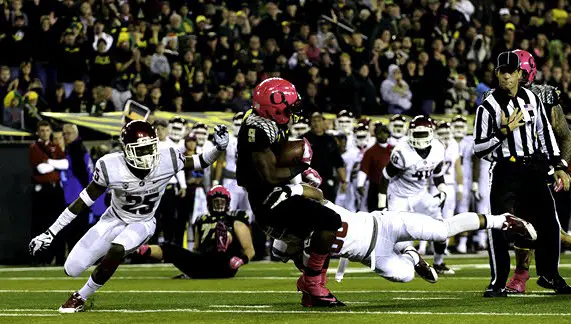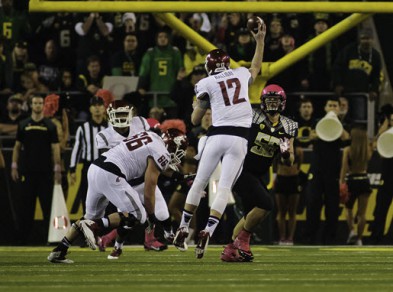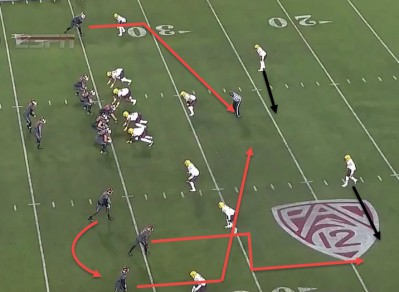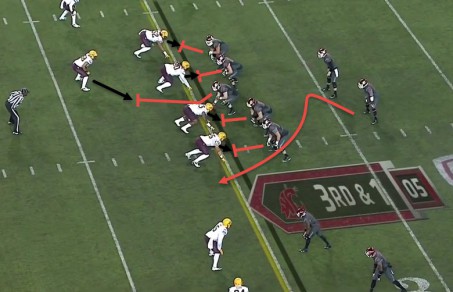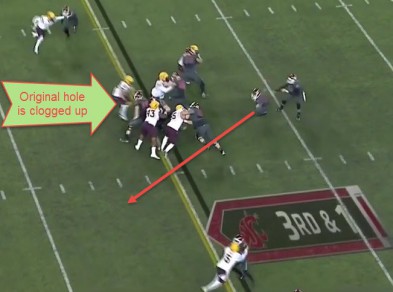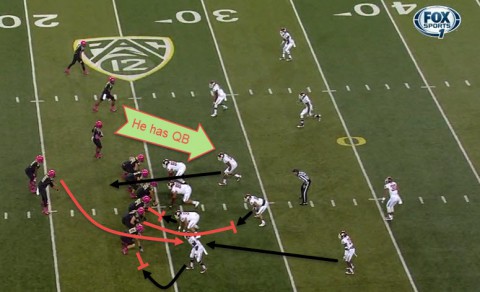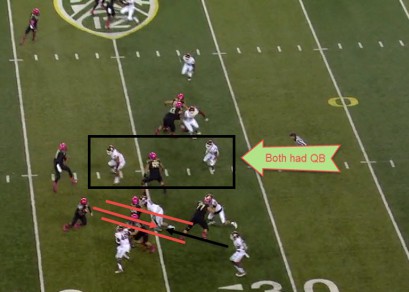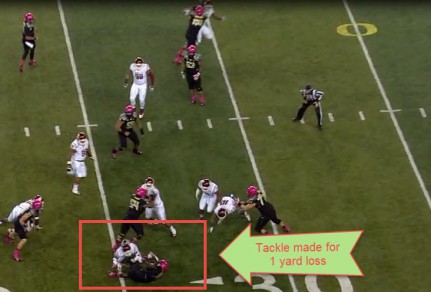OK, get your laughs in now. Joke about how terrible the Cougars are, including their defense. The usual: “My 6-year-old brother’s Pop Warner team could beat WSU.” You guys got the giggles out? Good. Now we can move on to business.
Washington State isn’t the joke you may think. They have a proven head coach, Mike Leach, in his second year as the Wazzu head coach, a veteran quarterback and 94.5 percent of their offensive production from last year returning.
That is a lot of developed production. Way more than Oregon, who’s at 77.5 percent. Also, the Cougs have a potent offense that can strike almost as fast as Oregon’s. Let’s look at how they do it:
WSU quarterbacks collectively attempted an average of 58 passes per game last year. That is easily Top 5 in the country.
Heck, Connor Halliday (QB No. 12) attempted a Football Bowl Subdivision record 89 passes against Oregon last year. It’s no different this year; look at their game against Rutgers, 532 passing yards and only six rushing yards.
Before we jump into a specific play, I’m going to introduce a favored WSU technique. It’s often called “crossing routes” or “pick routes.”
Crossing routes have players start with receivers on opposite sides of the field, and then cross paths in the middle of the field as they run their patterns. This attacks man coverage.
In that coverage, the man covering the receiver will most likely trail that receiver. The same goes for the defender covering the other receiver. When the two receivers cross paths, the defenders often have to adjust their paths. Optimally, now one of the receivers will be open and the QB can make a pass over the middle of the field.
There were few bright spots for Washington State in last year’s game against Arizona State, but when successful, you could see the WSU offensive strategy. On the opening play of the second quarter, Wazzu had the ball with 2nd-and-seven on the ASU 34. Halliday came out (above) and knew that ASU liked to play “5-Man Under.” In this play, the two outside receivers run delayed slants, and the other receivers run routes drawing the safeties away, leaving the middle open.
Right before Marks, the receiver wide right, hits the hashmarks (above), Halliday hits him on the run. Now the defender covering him feels the effects of crossing routes as he runs into the safety.
The last defender who can stop Marks from getting into the endzone is the man covering the other receiver running the crossing route. But since he’s covering the slant, his momentum is toward the middle of the field, which makes it nearly impossible for him to make the tackle. As a result, Marks is able to get into the endzone for the Cougs first score of the game.
Now, let’s talk about the dominance of WSU’s run game. Thank you for not closing your browser. I may have if someone was serious about that statement, because WSU has almost no run game. They run the ball almost 4 times less often than they throw it — roughly 3 or 4 passes to every run.
The offensive line is running a man-blocking scheme against a four-man front (above), so the center has to hit the right defensive end, and then move his way downfield to the linebacker in front of him.
It’s not clear whether the play is a read option or a designed run, but either way, Halliday hands the ball to his running back. The running back sees the hole he was supposed to run through is clogged on the right side of the line, so he cuts it back to a wide open left side and is able to get the first down, plus.
WSU isn’t known for defense, but they will try to stop the zone read this Saturday, by looking at a play from this game last year. As you can see above, the Cougars are playing a 3-3-5 defense.
At the snap, the left outside linebacker and the left defensive end create a hole for the running back by taking the linemen blocking them (above). This leaves only one Oregon player to block two WSU players. Whoever the lineman decides to not block steps into the hole and makes the one-on-one tackle. Of course, not an easy task against Marshall or Tyner.
Had Mariota instead kept the ball, the right outside linebacker would have been there to make the play, with a hole to get through the line. On this particular play, the nose tackle fought off his block extremely well, so he was there to make the play on Mariota.
The corner made a great tackle. The result (above) is a one-yard gain on 1st-and-10, making it a long second down play.
Based on the final score, WSU didn’t have many great defensive plays. However, the Cougs have the ability and the scheme to stop the zone read, and they’ve shown that. Now they just have to execute more consistently.
If WSU was able to make open field tackles more often and limit the big play, they could have a chance this weekend. The offense has the fire power and can put up points, so if the Cougars just put a cap on the Ducks’ explosion plays, makes open field tackles and gets stops on third down, this may be a close game. If they don’t, WSU fans better hope that Halliday & Co. have a career game.
“Oh, how we love to learn about our opponents on FishDuck.com.”
Rory Davidson
Opponent Football Analyst for CFFNetwork/FishDuck.com
Eugene, Oregon
Top photo by Craig Strobeck
Related Articles:
Chip Kelly Update: Everything's Good Again ...
Chip Kelly Update: Wailing and Gnashing of Teeth
Shock and Awe -- The Oregon Ducks' Football Hangover Effect
Despite Lopsided Score, Georgia State "Never Stopped Believing"
Hope Springs Eternal for Ducks
Incompetent Pac-12 Officials: How Do You Miss ALL of THIS?
Rory Davidson: Rory (Football Analyst) is a sophomore at Oregon in the fall (Class of 2018). He has been a devout Stanford football fan since he was 2 months old and is excited about the energy and greatness Oregon sports has to offer. For the past 6 years he has been doing advanced data analytics for his high school football team and working alongside the coaches to understand how they strategize about the game. He wants to integrate more statistics into his analyses and try to help readers learn about and understand the future of sports.

